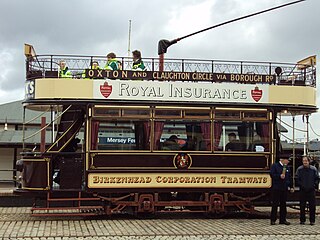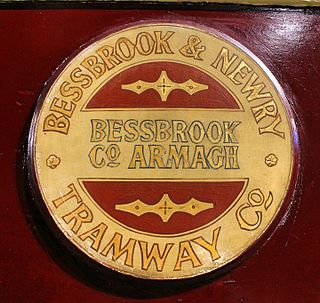Related Research Articles

The National Tramway Museum is a tram museum located at Crich, Derbyshire, England. The museum contains over 60 trams built between 1873 and 1982 and is set within a recreated period village containing a working pub, cafe, old-style sweetshop and tram depots. The museum's collection of trams runs through the village-setting with visitors transported out into the local countryside and back. The museum is operated by the Tramway Museum Society, a registered charity.

A horsecar, horse-drawn tram, horse-drawn streetcar (U.S.), or horse-drawn railway (historical), is an animal-powered tram or streetcar.

The Victorian Railways (VR), trading from 1974 as VicRail, was the state-owned operator of most rail transport in the Australian state of Victoria from 1859 to 1983. The first railways in Victoria were private companies, but when these companies failed or defaulted, the Victorian Railways was established to take over their operations. Most of the lines operated by the Victorian Railways were of 5 ft 3 in. However, the railways also operated up to five 2 ft 6 in narrow gauge lines between 1898 and 1962, and a 4 ft 8+1⁄2 instandard gauge line between Albury and Melbourne from 1961.
Birmingham City Transport was the local authority-owned undertaking that provided road-based public transport in Birmingham, England, between 1899 and 1969. It was locally known as the Corporation Buses. Initially, it was called Birmingham Corporation Tramways, and, after the first motor bus services started in July 1914, it became Birmingham Corporation Tramways and Omnibus Department in 1928. Finally, in November 1937, it was renamed "Birmingham City Transport", though Birmingham itself had been a City since 1889. It was incorporated into the West Midlands Passenger Transport Executive in 1969.

The Brill Tramway, also known as the Quainton Tramway, Wotton Tramway, Oxford & Aylesbury Tramroad and Metropolitan Railway Brill Branch, was a six-mile (10 km) rail line in the Aylesbury Vale, Buckinghamshire, England. It was privately built in 1871 by the 3rd Duke of Buckingham as a horse tram line to help transport goods between his lands around Wotton House and the national rail network. Lobbying from the nearby village of Brill led to its extension to Brill and conversion to passenger use in early 1872. Two locomotives were bought but trains still travelled at an average speed of 4 miles per hour (6.4 km/h).
Edinburgh Corporation Tramways formerly served the City of Edinburgh, Scotland. The city used four-wheeled double-decked trams painted dark red (madder) and white – a livery still used by Lothian Buses and the post-2014 Edinburgh Trams.

Public transport bus services are generally based on regular operation of transit buses along a route calling at agreed bus stops according to a published public transport timetable.
The Manchester Carriage and Tramways Company was incorporated in 1880, the result of a merger of the Manchester Suburban Tramways Company and the Manchester Carriage Company, to provide horse-drawn tram services throughout Manchester and Salford, England, and surrounding districts. Although the 1870 Tramways Act authorised local authorities to construct tramways, it prevented them from operating tram services, so the tramways were leased out to private companies who operated them on their behalf. Those companies also had the right to construct their own tramways.

Between 1901 and 1949 Manchester Corporation Tramways was the municipal operator of electric tram services in Manchester, England. At its peak in 1928, the organisation carried 328 million passengers on 953 trams, via 46 routes, along 292 miles (470 km) of track.

A horse-bus or horse-drawn omnibus was a large, enclosed, and sprung horse-drawn vehicle used for passenger transport before the introduction of motor vehicles. It was mainly used in the late 19th century in both the United States and Europe, and was one of the most common means of transportation in cities. In a typical arrangement, two wooden benches along the sides of the passenger cabin held several sitting passengers facing each other. The driver sat on a separate, front-facing bench, typically in an elevated position outside the passengers' enclosed cabin. In the main age of horse buses, many of them were double-decker buses. On the upper deck, which was uncovered, the longitudinal benches were arranged back to back.
The Manchester Carriage Company was established on 1 March 1865 to provide horse-drawn bus services throughout Manchester and Salford, in England. The company was the result of a merger between the competing transport interests of local rivals John Greenwood, Robert and James Turner, and Alderman Ivie Mackie. It was merged with the Manchester Suburban Tramways Company in 1880 to form the Manchester Carriage and Tramways Company.
The Manchester Suburban Tramways Company (MSTC) was set up in 1877 to provide horse-drawn tram services throughout Manchester and Salford, in England. The company's first tram service, which was also a first for Manchester, ran on 17 May 1877. The MSTC was merged with the Manchester Carriage Company in 1880 to form the Manchester Carriage and Tramways Company. The initial board of directors comprised Daniel Busby, William Turton, John Greenwood (1818-86), and Benjamin Whitworth.

The history of public transport authorities in Manchester details the various organisations that have been responsible for the public transport network in and around Manchester, England, since 1824.
The Brill Tramway, also known as the Quainton Tramway, Wotton Tramway, Oxford & Aylesbury Tramroad and Metropolitan Railway Brill Branch, was a six-mile (10 km) rail line in the Aylesbury Vale, Buckinghamshire, England. It was privately built in 1871 by the 3rd Duke of Buckingham as a horse tram line to transport goods between his lands around Wotton House and the national railway network. Lobbying from residents of the nearby town of Brill led to the line's extension to Brill and conversion to passenger use in early 1872. Two locomotives were bought for the line, but as it had been designed and built with horses in mind, services were very slow; trains travelled at an average speed of only 4 miles per hour (6.4 km/h).
The South Lancashire trolleybus system once served towns in South Lancashire, England, including Atherton, Bolton, Swinton and Leigh and St Helens. Opened on 3 August 1930, it replaced the South Lancashire Tramways network.

Birkenhead Corporation Tramways operated a tramway service in Birkenhead between 1901 and 1937.
The Worcester Electric Traction Company operated a tramway service in Worcester between 1904 and 1928.

The Bessbrook and Newry Tramway operated a 3 ft narrow gauge, hydro-electrically powered tramway transporting passengers and freight between Bessbrook and Newry in Northern Ireland between 1885 and 1948.
Bradford Corporation Tramways were a tramway network in the city of Bradford, West Riding of Yorkshire, England which operated trams from 1882 until 1950 and trolleybuses from 1911 until 1972. The track gauge of the tramways was 4 ft.

Stockport Corporation Tramways operated a tramway service in Stockport, England, between 1901 and 1951. It was preceded by a horse tramway from Levenshulme to Stockport, which opened in 1880, and was ultimately run by the Manchester Carriage and Tramways Company. A second independent horse tramway opened in 1890, running to Hazel Grove. In 1899 the Corporation bought the first line, electrified it, and leased it back to the operating company. Their powers to buy the Stockport and Hazel Grove Tramway, authorised by the same Act of Parliament, were not exercised until 1905.
References
- ↑ Gray, Edward (1977), The Manchester Carriage and Tramways Company, Manchester Transport Museum Society
- Hulme, Charles (1991). Rails of Manchester. Manchester: John Rylands University Library.